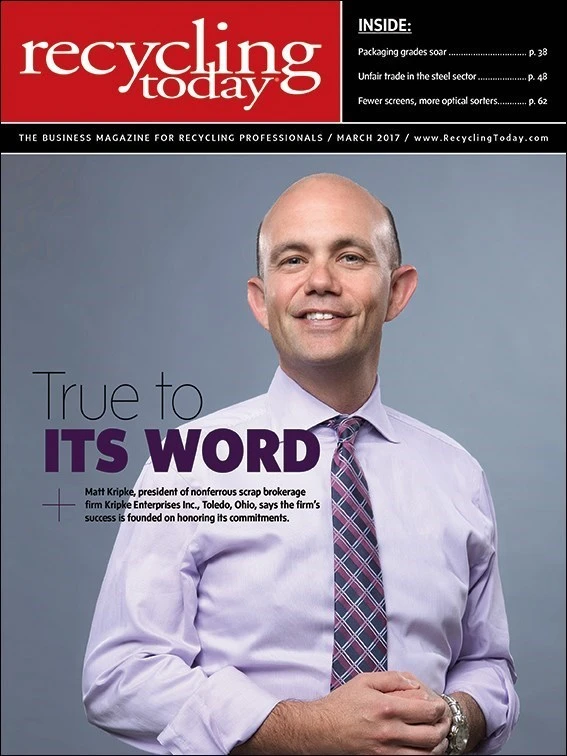
Metals producers have been foremost among those keeping World Trade Organization (WTO) arbitrators busy this decade, with steelmakers in nations on every continent urging their governments to take action against what they see as subsidized exported steel.
Steelmakers in China are mentioned most often as being problematic, with producers in other nations saying government favoritism in that country underwrites noncompetitive operators that, rather than face capacity cuts, pump out low-cost steel that is shipped around the world. (Aluminum producers have been making similar complaints, as spelled out in the feature “Limits to Growth” in the January 2017 Recycling Today Scrap Metals Supplement.)
Throughout his campaign for the White House, Donald Trump told voters he would not tolerate America being taken advantage of by trade deals perceived to have tilted the scale toward imported products streaming into the United States or American jobs being sent offshore.
Two of Trump’s advisors on trade—one of whom is now his Secretary of Commerce nominee—both have a steel industry background, prompting the sector to become an early proving ground for a new emphasis on trade complaints.
Tempered steel
Throughout the 2016 presidential campaign, Trump was advised by Daniel DiMicco, a former CEO of Charlotte, North Carolina-based steelmaker Nucor Corp. DiMicco eventually was appointed to President Trump’s transition team, with specific responsibilities for the Office of the U.S. Trade Representative (USTR).
The USTR describes itself as being “responsible for developing and coordinating U.S. international trade, commodity and direct investment policy and overseeing negotiations with other countries.”
During the later stages of the Obama administration, its website’s home page was used to tout the merits of the proposed Trans-Pacific Partnership (TPP) trade agreement between the U.S. and several other nations (not including China).
The TPP was a campaign issue in the 2016 election, with Bernie Sanders first criticizing Hillary Clinton’s public support of the agreement, and then Donald Trump criticizing her for changing her stance on the TPP. Within days of taking office, President Trump signed an executive order withdrawing the U.S. from the TPP.
DiMicco, both in his role as Nucor’s CEO and particularly in his capacity as a former chairman of the Washington-based American Iron and Steel Institute (AISI), has been harshly critical of the steel exporting activities of China and other nations.
The other Trump campaign advisor with a steel background was Wilbur Ross, who served as chairman of the former ISG Steel. That steelmaker, now part of Arcelor- Mittal, was based in the Cleveland area.
Ross subsequently has been nominated as the Trump Administration’s Secretary of Commerce and may be serving in that role by the time this publication goes to press.
Ross and DiMicco gave voice within the Trump campaign to metals producers, who have been among the foremost critics of China’s behavior as being at odds with its goal of being accepted as a market economy nation.
“Steel and other U.S. manufacturers continue to face significant trade challenges from foreign government trade-distorting policies and practices, in particular China’s state-owned enterprises (SOEs),” the AISI says on its Trade Policy web page. “A more aggressive U.S. trade policy is needed to combat these foreign trade-distorting practices in order to preserve and strengthen our nation’s manufacturing base,” the association contends.
Domestic support
In an early sign of taking the side of the domestic steel industry, a memorandum issued by the White House press secretary Jan. 24, 2017, asks the U.S. Commerce Department to “develop a plan under which all new pipelines, as well as retrofitted, repaired or expanded pipelines, inside the borders of the United States” use domestically made steel.
The memo says the Commerce Department can work in consultation with other federal agencies to ensure “all new pipelines, as well as retrofitted, repaired or expanded pipelines,” use “materials and equipment produced in the United States to the maximum extent possible and to the extent permitted by law.”
Defining what counts as domestically produced steel or pipe, the memo includes several examples:
- All manufacturing processes for iron or steel products, from the initial melting stage through the application of coatings, [must] occur in the United States.
- Steel or iron material or products manufactured abroad from semifinished steel or iron from the United States are not “produced in the United States” for purposes of the memorandum.
- Steel or iron material or products made in the U.S. from semifinished steel or iron of foreign origin are not considered “produced in the United States.”
The memo is one of several pipeline-related memos newly elected President Trump issued in his first week in office. Other memos issued addressed two specific oil pipelines, the Keystone XL Pipeline and the Dakota Access Pipeline, while another allows certain infrastructure projects, including pipelines, to receive a high priority status for environmental and regulatory review.
The steel capacity aspects of trade policy are intended to boost the fortunes of steelmakers in the U.S. More than one region of perceived steel overcapacity overseas may be targeted, but the primary target is clearly China.
Half a world away
Steel production figures gathered from the nations of the world and reported by the Brussels-based World Steel Association (WorldSteel) have indicated for many years that China’s output has far exceeded that nation’s ability to consume all its own steel.
The overcapacity situation in each of the past several years is not 7 million or 8 million tons, which could account for the exporting of specialty steels or steel exported to nearby nations that might be in an undercapacity situation.
Rather, China’s more than 800 million tons of steel produced annually exceeds its consumption by as much as 150 million or even 200 million tons. That amounts to far more steel than is made in any other single nation on Earth, including the United States. (In 2016, the U.S. produced less than 80 million metric tons total, according to WorldSteel.)
Steelmakers and their trade associations in other nations say that they have watched prices fall and have lost market share because of the situation and that they are up against SOEs in China that are being subsidized by their government.
The conversation—and the flurry of trade cases—has long been acknowledged by China’s central government, which has pledged capacity cutbacks through varying techniques.
In one of the most recent pronouncements, in mid-January 2017, government officials in one of the largest steelmaking regions in China reportedly pledged to curtail nearly 32 million metric tons of steel and iron output in 2017.
A government official in Hebei, the province north of Beijing, also pledged to cut nearly 50 million metric tons of steel output by 2020, according to an online report from Reuters, which cites China’s Xinhua news agency as its source.
Steel production figures gathered from the nations of the world and reported by the Brussels-based World Steel Association (WorldSteel) have indicated for several years that output in China has far exceeded that nation’s ability to consume all its own steel.
Reuters and Xinhua report that Zhang Qingwei, Hebei provincial governor, has said that four “zombie firms” in Hebei would be shut down in 2017, though he did not specify which firms.
The steel industry in China may be under pressure to reduce capacity in 2017 for two reasons: protests from other countries that say they are being flooded with imported steel and criticism from Chinese citizens who see the steel industry as a major air polluter.
In a separate online article from Xinhua, China’s environment minister is quoted as saying he “felt guilty” about the extraordinarily high levels of air pollution being experienced in parts of China in the opening days of 2017.
That news report refers to Chen Jining, leader of China’s Ministry of Environmental Protection (MEP), as acknowledging the public’s anxiety about air pollution, saying, “The root cause of the [Beijing-Tianjin-Hebei] region’s smog problems, from a long-term perspective, is the unclean industrial and energy mix, which require big changes.”
The MEP says measures that can be taken include phasing out “unclean and inefficient coal-fired boilers,” encouraging off-peak industrial production and enhancing “scrutiny and punishment for violations of the rules.”
World leaders in Washington and beyond seem unlikely to wait for anti-air pollution measures in China to take effect before taking steps to protect their own steel-producing industries.
Despite several years of Chinese government proclamations that steel overcapacity was a problem to be addressed, production figures for 2016 point to another year of no progress.
According to the year-end figures collected and reported by WorldSteel, mills in China produced 808 million metric tons of steel in 2016, a 1.2 percent increase over their 2015 output.
It is a figure unlikely to change the viewpoint of the AISI, which calculated that in 2016 imported finished steel enjoyed 26 percent market share in the U.S. In a 2016 policy document, the group states, “China continues to protect and increase its exports by manipulating its currency, raw material markets and border measures for steel and steel-containing goods.”
Get curated news on YOUR industry.
Enter your email to receive our newsletters.

Explore the March 2017 Issue
Check out more from this issue and find your next story to read.
Latest from Recycling Today
- Altilium produces EV battery cells using recycled materials
- Brightmark enters subsidiaries of Indiana recycling facility into Chapter 11
- Freepoint Eco-Systems receives $50M loan for plastics recycling facility
- PET thermoform recycling the focus of new NAPCOR white paper
- Steel Dynamics cites favorable conditions in Q1
- Hydro starts up construction in Spain
- Green Cubes unveils forklift battery line
- Rebar association points to trade turmoil





